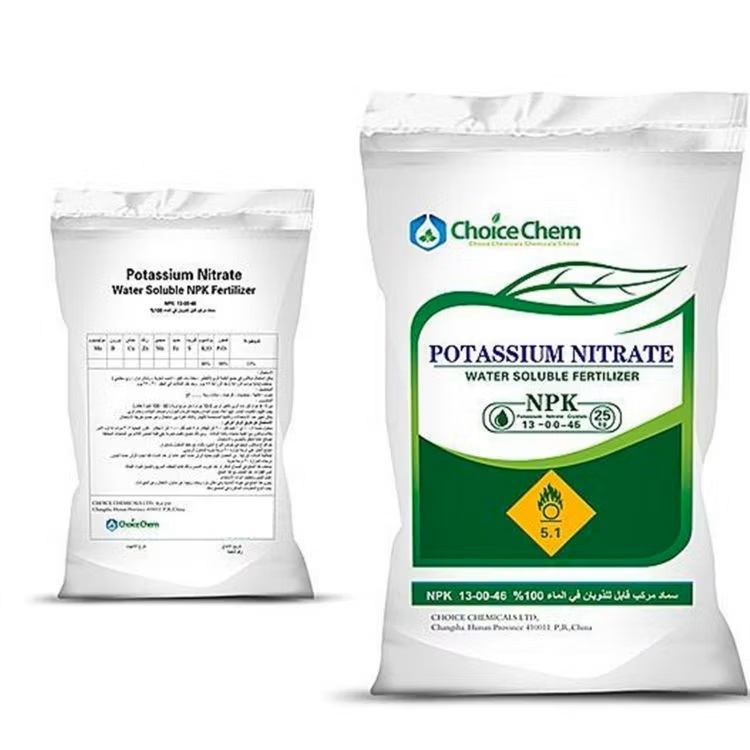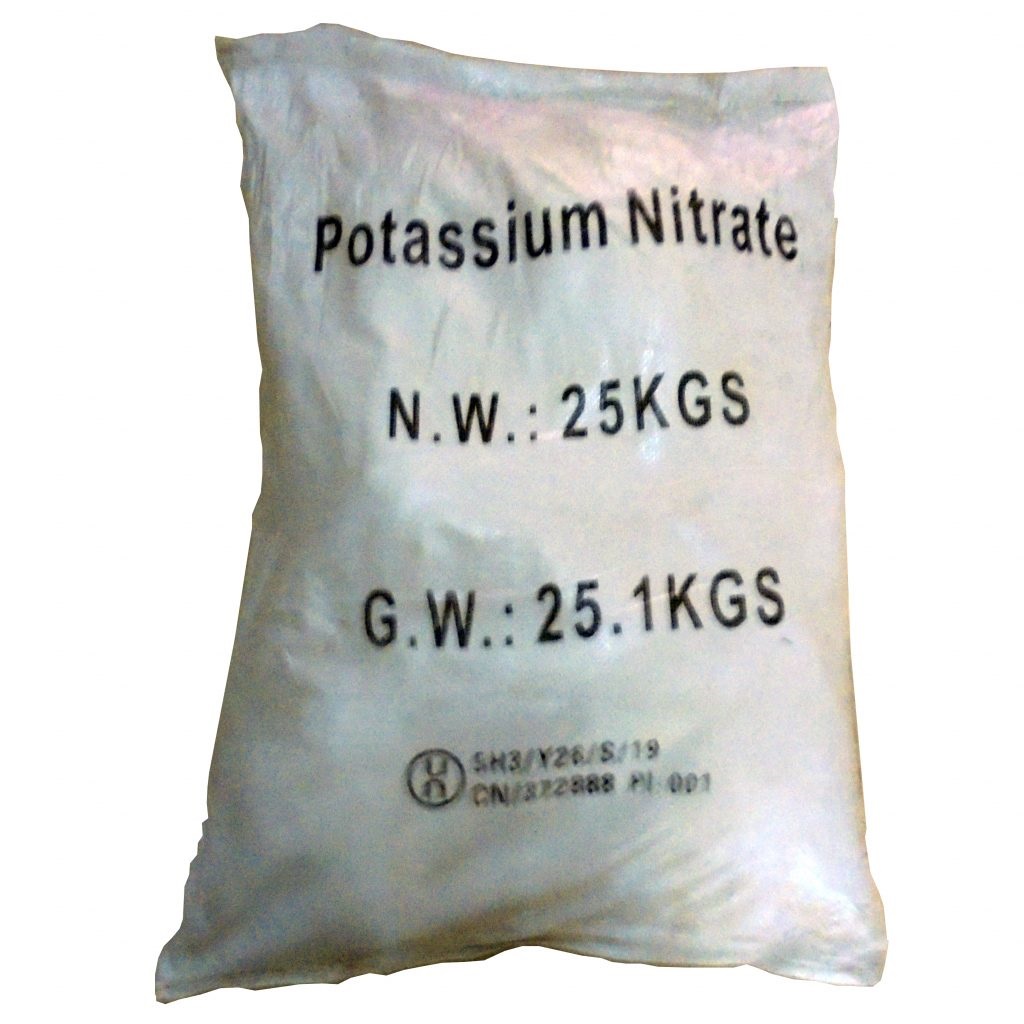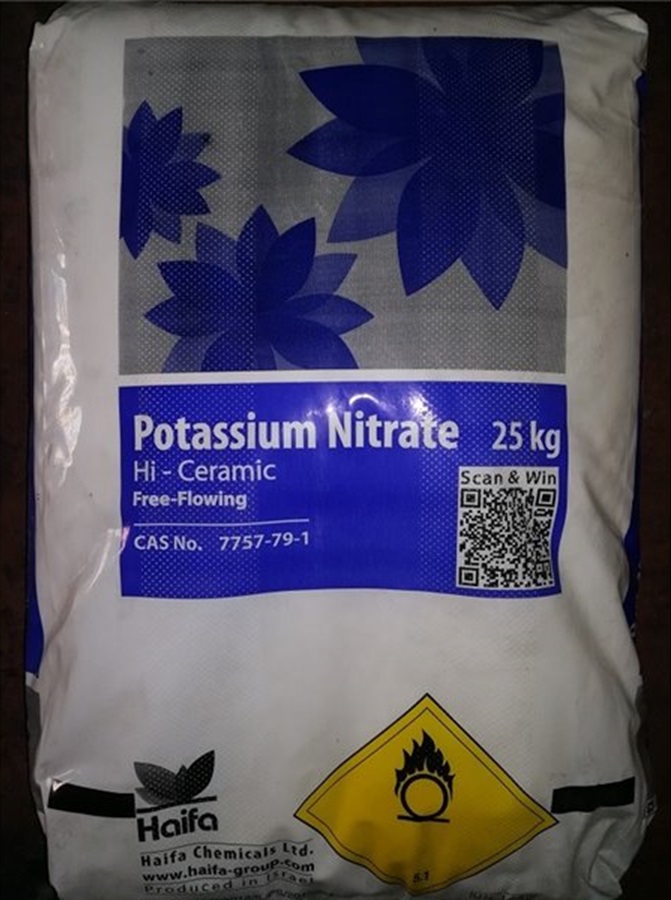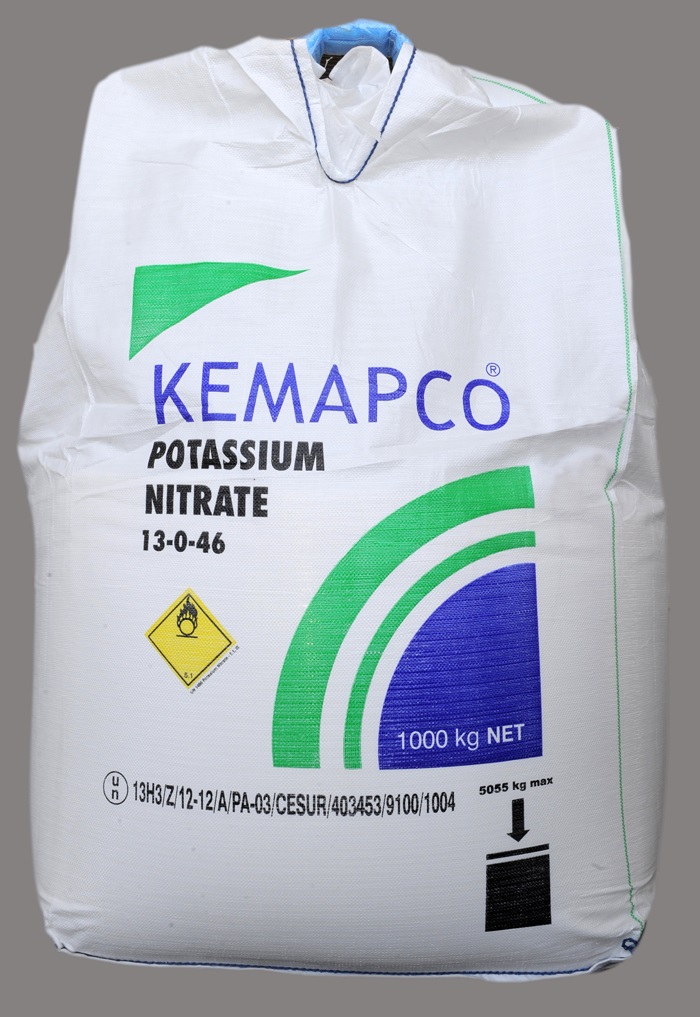We unleash your business potential by maximize the business innovation.
Send EmailPotassium nitrate, SALTPETER, 7757-79-1
CAS: 7757-79-1
Molecular Formula: KNO3
Names and Identifiers
Physico-chemical Properties
| Molecular Formula | KNO3 |
| Molar Mass | 101.1032 |
| Density | 1.00g/mLat 20°C |
| Melting Point | 334 °C (lit.) |
| Boling Point | 100°C750mm Hg |
| Flash Point | 400°C |
| Water Solubility | 320 g/L (20 ºC) |
| Solubility | H2O: 1M at20°C, clear, colorless |
| Vapor Presure | 49.8mmHg at 25°C |
| Appearance | Solid |
| Specific Gravity | 2.109 |
| Color | white |
| Merck | 14,7648 |
| PH | 5.0-7.5 (50g/l, H2O, 20℃) |
| Storage Condition | Store at RT. |
| Stability | Stable. Strong oxidizer - contact with combustible material may cause fire. Incompatible with combustible materials, strong reducing agents. |
| Sensitive | Hygroscopic |
| Physical and Chemical Properties | Character: colorless orthorhombic crystal or white powder. melting point 334 ℃ relative density 2.109 solubility soluble in water, soluble in liquid ammonia and glycerol. Insoluble in ethanol and ether. |
| Use | Used in the manufacture of pyrotechnic, black powder, matches, ceramic glaze, glass clarifier, fertilizer, etc |
Risk and Safety
| Risk Codes | R8 - Contact with combustible material may cause fire R36/38 - Irritating to eyes and skin. R36/37/38 - Irritating to eyes, respiratory system and skin. R22 - Harmful if swallowed |
| Safety Description | S26 - In case of contact with eyes, rinse immediately with plenty of water and seek medical advice. S17 - Keep away from combustible material. S36 - Wear suitable protective clothing. S7 - Keep container tightly closed. S24/25 - Avoid contact with skin and eyes. |
| UN IDs | UN 3264 8/PG 3 |
| WGK Germany | 1 |
| RTECS | TT3700000 |
| TSCA | Yes |
| HS Code | 2834 21 00 |
| Hazard Class | 5.1 |
| Packing Group | III |
| Toxicity | LD50 orally in rabbits: 1.166 g anion/kg, Dollahite, Rowe, Southwest. Vet. 27, 246 (1974) |
Upstream Downstream Industry
| Raw Materials | Potassium chloride Nitric acid Ammonium nitrate Sodium nitrate |
| Downstream Products | Potassium nitrate Potassium periodate Gentamycin Solution |
Nature
colorless transparent orthorhombic or cubic prism crystal or white crystalline powder. Melting point 333 C; d 2.11. Deliquescence. Thermal decomposition. 19 The product is soluble in 2. 8mL water, 0.5mL boiling water, 620mL ethanol, soluble in glycerol, insoluble in anhydrous ethanol. When dissolved in water, the temperature can be reduced, and the pH value of the aqueous solution is about 7. 400 C decomposition of oxygen release; With strong oxidation. When contacted or mixed with organic matter, reducing agents, flammable substances, etc., there is a risk of combustion and explosion.
Preparation Method
Industrial potassium nitrate was dissolved in hot water, potassium carbonate was added, and impurities were removed by boiling. After filtration, the filtrate was cooled with stirring. The crystals were removed by Suction filtration and dried to obtain pure potassium nitrate.
Last Update:2022-01-01 09:02:48
Standard
This product is calculated as dry product, containing less than 99.0% of K N 0 3F.
Trait
- This product is white or colorless transparent crystal.
- This product is soluble in water, slightly soluble in ethanol.
Use
analysis reagent for trace analysis of manganese and sodium. Also used for strong oxidants, potassium salt synthesis, explosive manufacturing, Glass ingredients.
Differential diagnosis
This product is potassium salt and nitrate identification reaction (General 0301).
Safety
rabbit oral LDso:1.166G anion/kg. Inhalation of dust or fog, the respiratory tract irritation, high concentrations of inhalation can cause pulmonary edema. Staff should be well protected, if accidentally touch the eyes, should immediately rinse with a large amount of flowing water. The working environment should have good ventilation conditions. This substance may be harmful to the environment and has an accumulation effect in groundwater. Keep away from fire and heat source. Should be stored separately from flammable, combustible materials, reducing agents, sulfur, phosphorus, etc.
Exam
pH
take this product 1. 0g, add 10ml of fresh boiling water to dissolve, add 1 drop of human bromothymol blue indicator solution, and use hydrochloric acid titration solution (0. Olmol/L) or sodium hydroxide titration solution (0. Olmol/L) titration until the solution changes color, consumption titration liquid volume should not pass 0. 5mL.
clarity and color of solution
take this product l .O g, add water 10ml to dissolve, check according to law (General rule 0901 and general rule 0902), the solution should be clear and colorless.
chloride
take this product l.O g, check according to law (General rule 0801) and standard sodium chloride solution 2. 0m l made of control liquid comparison, not more concentrated (0.002%).
sulfate
take this product l .O. g. Check according to law (General rule 0802) and standard potassium sulfate solution 1 .5ml made of the control solution, shall not be more concentrated (0.015%).
reducing substance
take l.O g of this product, add 10ml of water to dissolve, add 0. 5ml of dilute sulfuric acid and 2ml of zinc iodide starch indicator solution, and the solution will not change blue within 2 minutes.
loss on drying
take about l g of this product, weigh it accurately, dry it at 105°C to constant weight, and lose no more than 0 .5% of weight (General rule 0831).
ammonium salt
take 0808g of this product and check it according to law (general rule). Compared with the control solution made of standard ammonium chloride solution 1 and 0ml, it should not be more concentrated (0. 005%).
calcium salt
take 2.0g of this product, add 15ml of water to dissolve, as a test solution. Prepare standard calcium solution with alcohol (accurately weigh 2.50g calcium carbonate, put it in a 1000ml measuring flask, add 12ml acetic acid, add appropriate amount of water to dissolve, dilute it to scale with water, and shake well, as a stock solution of calcium solution. Immediately before use, take 10ml of calcium solution stock solution, put it in a 100ml measuring flask, dilute it to the scale with ethanol, shake well, each 1ml is equivalent to 0.1 mg of calcium) 0.2M l, put in Nessler's colorimetric tube, add 4% ammonium oxalate solution (1ml), after 1 min, add dilute acetic acid (1ml) and the mixture of test solution (15ml), shake, place for 15 min, as a test tube; Take the Nessler colorimetric tube, add alcohol to prepare standard calcium solution 0.2ml,4% ammonium oxalate solution 1ml,1 minutes later, add standard calcium solution (before use, accurately take 1ml of calcium solution stock solution,
In a 100ml measuring flask, dilute to the scale with water and shake. Each lm l corresponds to calcium 10(ug)10.0ml, dilute acetic acid lm l and water 5ml, shake, 15 minutes, as a control tube. Compared with the control liquid tube, the test tube should not be more concentrated (0.005%).
Iron Salt
take this product 0807G, check according to law (General rule 0.001%), compared with the standard iron solution into the control solution, not more concentrated ().
sodium salt
take l.Og of this product, put it in a 100ml measuring flask, dilute it to the scale with water, shake it well, and use it as a test solution. Another 120g of reference sodium chloride (equivalent to sodium 0 .2G), diluted with water to make each 1 ml of sodium 0.5ug,1.0ug, 1.5ug, 2.0ug of the control solution. According to Atomic Absorption Spectrophotometry (General rule 0406 first method), measured at the wavelength of 589.Onm, using water as a blank solution, according to the multipoint working curve method, calculation. Sodium content should not exceed 0.10%.
Heavy metals
This product l.Og, inspection according to law (General Principles 0821 The first law), containing heavy metals shall not exceed 10 parts per million.
Content determination
- take 0.2g of this product, weigh it accurately, add 20ml of water to dissolve it, and transfer it to the treated strong acid cation exchange resin column, the resin column was washed with water (flow rate of about 3m l/min), and about 250ml of the exchange solution and washing solution were collected, and 1ml of phenolphthalein indicator solution was added. lmol/L) titration to the end point. Each l of sodium hydroxide titration solution (0.1 mol/L) corresponds to 10.11 m g of kno3.
- the treatment method of cation exchange resin is as follows: 15g of cation exchange resin in sodium salt state, add appropriate amount of water, transfer to ion exchange column, add 30 ~ 40ml of 2mol/L hydrochloric acid solution from the top, open the piston, make hydrochloric acid soak the resin, then close the piston, soak overnight, wash the resin column with 300 ~ 500ml of fresh boiling cold water, and take 100ml of the final wash solution, add 2~3 drops of phenolphthalein indicator solution and sodium hydroxide titration solution (0. Lmol/L) l drops, such as pink, can be used for the test.
Category
pharmaceutical excipients, osmotic regulator.
Storage
sealed storage.
Reference Information
| solubility in water (g/100ml) | grams dissolved per 100ml of water at different temperatures (℃): 13.9g/0 ℃;21.9g/10 ℃;31.6g/20 ℃;45.3g/30 ℃;61.3g/40 ℃ 106g/60 ℃;167g/80 ℃;203g/90 ℃; 241g/100 ℃ |
| identification test | solubility soluble in water; Poorly soluble in ethanol and glycerol. According to the OT-42 method. The potassium Identification Test (1T-27) was positive (10% sample solution). The nitrate Identification Test (IT-23) was positive (10% sample solution). |
| content analysis | accurately weigh about 0.4g of sample (pre-dried at 105 ℃ for 4H), dissolve into 300ml of water in a 500ml round bottom flask. After 3g of gadvada alloy powder and 15ml of 40% sodium hydroxide solution, an anti-splash ball and a condenser were connected to the flask. Put 50ml of 0.1mol/L sulfuric acid in the receiver, stand for 2H, distill to ML of distillate, titrate excess sulfuric acid with 0.1mol/L sodium hydroxide, three drops of Methyl red-methylene blue solution (TS-150) were used as an indicator. At the same time, the blank test was carried out, and the necessary correction was made. Each ml of 0.1mol/L sulfuric acid corresponds to 10.11mg of potassium nitrate (KNO3). |
| toxicity | ADl 0-3.7(NO3-, but not for infants under 3 months; FAO/WHO,2001). No special provisions (EEC). LD 503,236mg/kg (rat, oral). Children less than six months after birth are particularly sensitive to nitrate, so they are not suitable for children's food. after drinking water containing 50~100 mg/L potassium nitrate, the denatured hemoglobin in blood was significantly increased. Adl 0~5(FAO/WHO,1985). LD503236 mg/kg (rat, oral). Children within 6 months after birth are particularly sensitive to nitrate, so it is not suitable for children's food. According to FAO/WHO(1984), it can be used for cooked ham and cooked pig fore leg meat, and the maximum usage amount is 500 mg/kg (the dosage alone or in combination with sodium nitrate is calculated as sodium nitrate); typical cheese 50 mg/kg. According to the regulations of Japan, the maximum amount of use: 0.2g/kg of milk with cheese as raw material; Sake is 0.1g/L. in the production of inhalation of potassium nitrate dust, after several months, the nasal mucosa ulcer. Drinking water containing 50~100 mg/L potassium nitrate, blood denatured hemoglobin increased significantly. Has a stimulating effect on the skin. Production personnel should wear masks at work to prevent inhalation of potassium nitrate dust and protect respiratory organs; Wear work clothes and latex gloves to protect the skin. |
| usage limit | FAO/WHO(1984,mg/kg): cooked ham, cooked pig fore leg, 500; typical cheese 50 (used alone or in combination with sodium nitrate). GB 2760-2001: meat products 0.50g/kg. |
| purpose | for use as Analytical reagents and oxidants, it is also used in the synthesis and formulation of potassium salts. Explosives are used in the food industry as coloring agents, color fixatives, antimicrobial agents, preservatives, such as for cured meat, in the lunch meat. is the raw material for the manufacture of black powder, such as mine powder, FIRE WIRE, fireworks and so on. Also used in fireworks to produce purple Sparks. Mechanical heat treatment is used as a salt bath for quenching. The ceramic industry is used for the manufacture of porcelain glaze color coating. Used as a glass fining agent. For the manufacture of automotive lamp glass shell, optical glass tube glass shell. Pharmaceutical industry for the production of penicillin potassium salt, rifampicin equal drug. For the manufacture of cigarette paper. Used as a catalyst. Mineral concentrator. Used as a compound fertilizer for crops and flowers. coloring agents; Antimicrobial agents; Preservatives; Color fixatives. potassium nitrate is also the color-developing agent permitted in China. It in meat products due to the role of bacteria and reduced to potassium nitrite and the role of color protection and antibacterial. China's provisions can be used for meat products, the maximum use of 0.5g/kg, residues should not exceed 0.03g/kg. used in the manufacture of pyrotechnic, black powder, matches, ceramic glaze, glass clarifier, fertilizer, etc. strong oxidant. Flux. For emission spectroscopy. Synthesis of potassium salts. For photography. The haploid breeding medium and agricultural microorganism "5406" medium were prepared by the analysis of manganese and sodium. |
| production method | sodium nitrate and potassium chloride are dissolved in water for double decomposition reaction, and a precipitate is formed, filtered and concentrated by evaporation; when the relative density of the solution is 1.45~1.49(45~48 ° Bé) and the temperature is 119 ℃, sodium chloride is first precipitated; Sodium chloride is filtered by vacuum filtration, the filtrate was diluted with 10%-15% water, and cooled to 25-30 ℃. After 24h, potassium nitrate crystals were precipitated, and then vacuum filtered and dried at 80 ℃ to obtain a finished product. NaNO3 + KC → KNO3 + NaCl is derived from the metathesis of sodium nitrate and potassium chloride. industrial production includes double decomposition method and ion exchange method. Using potassium chloride and ammonium nitrate (instead of sodium nitrate) as the raw material of the double decomposition method, potassium chloride and dilute nitric acid as the raw material of the ion exchange method and solvent extraction method, potassium chloride, ammonium nitrate, ammonium bicarbonate as the raw material of the internal circulation method, ammonium nitrate, potassium chloride as raw material circulation method and other processes are in the stage of Process Research. Double decomposition method of sodium nitrate is added to the reactor containing the right amount of water, with steam heating, under stirring to dissolve all sodium nitrate, then according to NaNO3:KCl = 100:85 ingredients than slowly add potassium chloride metathesis reaction to produce potassium nitrate, when the solution concentration of heating evaporation to 45~48 ° Bé, the temperature of 120 ° C, the first precipitation of sodium chloride. After vacuum filtration, the sodium chloride crystals were washed with a small amount of hot water to reduce the band loss of potassium nitrate. The filtrate is sent to the crystallizer, diluted with 10% ~ 15% of the filtrate, cooled while stirring, after 24h, potassium nitrate crystals are precipitated, after vacuum filtration, water washing and centrifugal separation, it is sent to the air flow dryer and dried at 80 ° C. Or more to obtain the finished potassium nitrate. The NaNO3 + KCl → KNO3 + NaC1 ion exchange method uses potassium chloride and ammonium nitrate as raw materials to convert potassium ammonium ions in potassium chloride and ammonium nitrate solution on ion exchange resin, A potassium nitrate solution and an ammonium chloride solution were obtained. NH4NO3 + KR → NH4R + KNO3KCl + NH4R → KR + NH4Cl is concentrated by evaporation, filtered, the filtrate is cooled and crystallized, filtered, washed with water, centrifuged and air-dried to obtain potassium nitrate finished product. The production method of potassium nitrate includes the double decomposition method of sodium nitrate and potassium chloride, and the absorption method of absorbing nitric acid tail gas with potassium carbonate or caustic potassium solution. However, the double decomposition method is widely used in industry. Double decomposition method of sodium nitrate is added to the reactor containing the right amount of distilled water, with steam heating, under stirring to dissolve, and then according to NaNO3:KCl = 100:85 ingredients than slowly add potassium chloride for metathesis reaction to generate potassium nitrate, add arsenic removal agent and heavy metal removal agent, purify the solution, filter to remove impurities, the filtrate is heated and evaporated until the concentration of the solution reaches 45~48 ° Bé, and when the temperature reaches 120 ° C, sodium chloride is first precipitated, and the filtrate is sent to the crystallizer through vacuum filtration, dilute with 10% ~ 15% of the filtrate, cool while stirring, after 24h, precipitate potassium nitrate crystals, vacuum filtration, water washing, centrifugal dehydration, air drying at 80 ℃ or above, the finished product of edible potassium nitrate was prepared. NaNO3 + KCl → KNO3 + NaC1 |
| category | oxidant |
| toxicity grade | poisoning |
| Acute toxicity | oral-rat LD50: 3750 mg/kg |
| explosive hazard characteristics | can be mixed with organic matter, sulfur and phosphorus |
| flammability hazard characteristics | High Heat releases oxygen; Flammable in case of organic matter, reducing agent, charcoal, sulfur, phosphorus and other flammable substances; toxic NOx smoke from combustion |
| storage and transportation characteristics | warehouse ventilation; Light loading light unloading; And organic matter, reducing agent, charcoal, separate storage of sulfur and phosphorus combustibles |
| extinguishing agent | water mist |
| Occupational Standard | TWA 5 mg/m3); Tel 5 mg/m3 |




